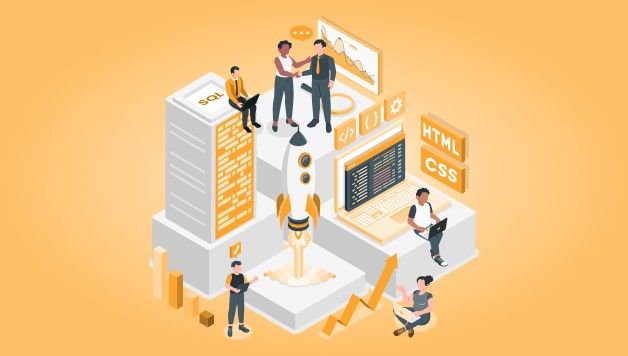The Future of Full Stack Developer Frameworks: What’s Next in 2025
Web development has undergone massive transformations over the past decade, and 2025 marks another turning point. Businesses are no longer satisfied with basic digital solutions—they demand intelligent, scalable, and AI-powered applications that deliver seamless user experiences. At the heart of these innovations lie Full Stack Developer Frameworks, which enable developers to build both client-side and server-side components efficiently.
For developers, tech leaders, and business owners, understanding the evolution of these frameworks is crucial. Whether you’re adopting a modern full stack framework or exploring advanced AI integrations, the coming years will reshape how applications are built, deployed, and scaled.
Why Full Stack Developer Frameworks Are Evolving
Rapid Technology Adoption
The pace of technological innovation is faster than ever. Businesses are leveraging frameworks that integrate cloud-native tools, real-time analytics, and AI capabilities to keep up with consumer demands.
Rising Importance of AI and Automation
Modern frameworks are embedding AI modules to enable features such as automated testing, code generation, and predictive personalization. Developers no longer just write code—they orchestrate intelligent systems.
Focus on Developer Productivity
By offering pre-built libraries, advanced debugging, and seamless integrations, frameworks reduce repetitive tasks and allow developers to focus on innovation.
Key Trends Defining the Future of Full Stack Developer Frameworks
1. AI-Powered Development Environments
Frameworks in 2025 are increasingly equipped with AI copilots that suggest code, detect bugs, and recommend optimizations. This not only accelerates development but also ensures more secure applications.
2. Cloud-Native and Serverless Architectures
The future belongs to serverless models where applications scale automatically without manual infrastructure management. Frameworks are adapting to integrate with AWS Lambda, Google Cloud Functions, and Azure seamlessly.
3. Integration with Machine Learning Models
From natural language chatbots to recommendation engines, Full Stack Developer Frameworks are evolving to directly integrate machine learning APIs, reducing the complexity of AI-driven app development.
4. Enhanced Security by Design
Frameworks are embedding advanced security features, such as real-time threat detection, automated patching, and compliance-ready modules. This is critical as cyber threats become more sophisticated.
5. Real-Time and Edge Computing Capabilities
In industries like IoT and finance, real-time responsiveness is essential. Frameworks that support edge computing ensure faster data processing closer to the user.
Top Frameworks Developers Should Watch in 2025
React + Node.js
Still one of the most powerful pairs, React and Node.js dominate for dynamic frontends and scalable backends. The duo continues to evolve with stronger AI and real-time features.
Angular + NestJS
Angular provides structure, while NestJS brings a TypeScript-powered backend. Together, they offer enterprise-ready solutions with robust AI compatibility.
Vue.js + Laravel
This combination remains popular for startups and small businesses due to its flexibility, simplicity, and integration capabilities.
Django + React
Django’s Python foundation makes it a favorite for AI-heavy applications, while React ensures a smooth user experience.
ASP.NET Core + Blazor
Microsoft’s stack remains a reliable choice for enterprises, offering strong cloud integration and security features.
Benefits for Businesses and Developers
Faster Development Cycles
Pre-built modules and automation tools reduce time-to-market, a crucial advantage in competitive industries.
Cost Efficiency
Businesses can save resources by adopting modern frameworks that streamline infrastructure and reduce manual intervention.
Scalability
As demand grows, Full Stack Developer Frameworks scale easily to handle high traffic and large datasets without compromising performance.
Future-Proof Applications
Frameworks that adapt to AI, edge computing, and cloud-native environments ensure long-term viability for apps built today.
Role of Professional Services
Not every organization has in-house expertise to leverage these frameworks effectively. Many businesses turn to experts offering fullstack development services to ensure scalable, secure, and AI-ready digital solutions. This approach minimizes risk while maximizing innovation potential.
The Road Ahead for Full Stack Frameworks
As 2025 unfolds, developers and businesses should prepare for a more AI-driven ecosystem. Future-ready frameworks will go beyond just supporting development—they will act as intelligent partners in building solutions. Those who adopt the right full stack framework now will be best positioned to lead in the next wave of digital transformation.
Conclusion
The future of Full Stack Developer Frameworks is not only about improving speed or scalability—it’s about enabling intelligent, adaptive, and secure applications that meet evolving business and user needs. From AI-powered copilots to serverless backends, the possibilities are endless.
For developers, mastering these frameworks is no longer optional; it’s essential. For businesses, leveraging these innovations means staying ahead of the competition. As we move forward, one thing is clear: frameworks will continue to define the future of web innovation in 2025 and beyond.




Leave a Reply
Want to join the discussion?Feel free to contribute!